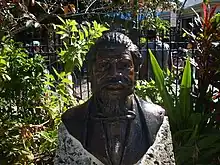Sandy Cornish
Sandy Cornish (1793–1869) was an African American farmer, businessperson, and civic leader in Key West, Florida. As a former slave who had purchased his freedom, he publicly maimed himself to prevent being returned to slavery.
Sandy Cornish | |
|---|---|
 Sculpture of Cornish in Mallory Square | |
| Born | 1793 |
| Died | 1869 (aged 75–76) |
| Nationality | American |
| Occupation(s) | Farmer, civic leader, former slave |
| Spouse | Lillah Cornish |
Slavery and freedom
Cornish was born a slave in Maryland in 1793.[1] In 1839, his master hired him out to a railroad-building project in Port Leon in Florida's Panhandle. The position allowed him to earn money for himself, and after nine years of work at $600 a year, he was able to purchase his own freedom and that of his wife Lillah.[1] However, the papers showing him to be free were destroyed in a fire. Lacking proof of his emancipation, he was seized by slave traders, but managed to break free. The next day he gathered a crowd of onlookers in Port Leon. He loudly proclaimed that, having purchased his freedom once, he would not return to slavery under any circumstances. He then deliberately maimed himself, stabbing himself in the leg, slashing the muscles of one ankle, and cutting off a finger of his left hand, which he proceeded to sew back on with a needle and thread.[1] These injuries made him worthless as a slave and thus immune to recapture. Friends took him home in a wheelbarrow, and he eventually recovered his health.[2]
Key West
Around 1850, he and Lillah bought a farm in Key West, in the area that is now Truman Avenue near Simonton Street. Selling vegetables and fruits to local residents, he became one of the wealthiest people in Key West.[2][3] He was a leader of the local black community and the founder of the Cornish Chapel of the African Methodist Episcopal Church, now the Cornish Memorial AME Zion church and chapel, which still stands at 702 Whitehead Street.[4][5]
He died in 1869 at the age of 76.[1] He was buried in Key West Cemetery, but the location of his grave was lost to history. In 2014, the cemetery and the Historic Florida Keys Foundation installed a plaque to his memory.[6] Speakers described his life as an inspiring testament to human freedom. City Commissioner Clayton Lopez, presiding over the ceremony, said, "His actions in life show that he was not going to accept the fate developed for him by lesser men. He is a legend that continues to point the way to human dignity to this day."[1]
Recognition
A memorial bust of Cornish is included in the Mallory Square Sculpture Garden, which honors people who had a significant impact on Key West.[7][8]
References
- "Freed Slave Sandy Cornish Gets a Marker in Cemetery". South Florida Times. February 19, 2014. Retrieved 17 January 2016.
- "The Key West Man Who Refused To Be A Slave". Ralie Travels. December 9, 2013. Retrieved 17 January 2016.
- Schmidt, Louis G. (Spring 1994). "From Slavery to Freedom and Success: Sandy Cornish and Lillah Cornish" (PDF). Florida Keys Sea Heritage Journal. 4 (3).
- White, Dan (May 14, 2010). "Key West church is a powerful testament". The Augusta Chronicle. Retrieved 28 January 2016.
- "Cornish Memorial AME Zion church and chapel – Key West, Florida". Florida Memory. Retrieved 17 January 2016.
- "Please Join Us For the Sandy Cornish Memorial Dedication". Key West: The Newspaper. February 15, 2014. Retrieved 17 January 2016.
- "Key West Historic Memorial Sculpture Garden". keywestsculpturegarden.org. Retrieved 18 January 2016.
- "Sandy Cornish (c1793 – c1869) – Key West Florida". Functional Culture. December 5, 2008. Retrieved 17 January 2016.